1935 - Turning Point and What-Ifs
Posted by Mahoning63 On 2015/8/30 10:59:58
The recent post on Romney's selective memory (a real thought provoker, Steve203 - thanks for posting) got me thinking about that long debated "turning point" for Packard, and certainly we all have our favorites. My mind keeps wondering back to 1935 because it was here the singular Packard arguably split itself into two Packards. It still made the Seniors, struggling not only because of the Depression but because the market, technology and manufacturing were fast moving on. And it now made the Juniors, a more mass market premium car that had moved on but also needed compelling Seniors selling alongside it to fully realize its value in the market.
With this in mind, let's take a hard look at those '35 Seniors. Yes, they looked good, had presence, exuded luxury and offered high craftsmanship. But they were based on now old-school production methods, were heavy for their size, didn't have an independent front suspension like GM and didn't make good profits. My conclusion: they should have never been made!
Look back at 1923-24 when Packard dropped the Twin Six and abruptly shifted to its new flagship, the Eight, that was based on its more modern and production-efficient Six. For several years afterward, Packard's fortunes rose dramatically.
Now think about this analogy: in 1924, what if Packard had not made the new Eight but instead restyled the Twin Six and sold it alongside the Six for the next five years? Where would Packard have been in 1928? Quite possibly in the same boat Pierce-Arrow found itself in, having sold the old-school Model 33 alongside its new for 1925 Model 80.
With this in mind, I set to work once again on altering images of the One Twenty to see what was possible in terms of Senior potential, and came up with this:
- around 1933, Macauley would have realized that not only was a lower priced car of a completely new type needed, but that the current models had run their course, the competition having caught up to them in content and beaten them in value.
- Macauley would conclude that 1935 would need to be the year Packard once again made an about-face as it had in 1924. The entry and prestige cars would be based on the new One Twenty architecture, sharing many components and bodies. The money earmarked for restying the '34 Seniors would be redirected to the new program. Only if timing and resources prevented the new Seniors from launching in 1935 would the '34 models be carried over one more year. By 1936 at latest, all Packards would roll down the One Twenty line.
- let's give the new prestige cars a name... One Sixty, for lack on anything more creative... to represent their horsepower running on a new 356 I8 that was based on the One Twenty I8. Or perhaps they could have been called One Eighty, with a V12 based on the One Twenty I8 underhood. I have concluded that the motor powering these new Seniors was not as important as their bodies, styling, interior craftsmanship and One Twenty underpinnings.
- Junior bodies would become Seniors by simple addition of 6 inches to hood/front fender length.
- styling finesse would be the order of the day and Packard would get very persnickety about this. The standard One Twenty sedan had clean flowing lines in the rear. With a 6 inch longer hood mated to this body the new Seniors would look every bit as good as the Series 1200 sedan that we are familiar with. But the One Twenty touring sedan, club sedan and coupe sedan would not make it, their bustle back trunks not meeting the "only flowing lines" mantra. Instead, a coupe-sedan body on 6 inch shorter wheelbase would provide room of club sedan, and a new touring sedan on 10 inch wheelbase stretch from standard sedan would allow a decklid that flowed naturally from the body and didn't stick out 6 inches relative to the rear fenders, as the One Twenty's did.
- the CD-138 doors, which appear to have been 4 inches longer than the One Twenty's and with the rear door termination moved forward 10 inches, would form the basis for the 7 pass vehicles, on 138 wb for the One Twenty and 144 wb for One Sixty owing to longer hood.
- the former One Twenty 2-4 Coupe body would move back 6 inches to improve proportions, and would become a 2 pass only vehicle (question for forum: did rumble seats still sell in meaningful numbers by 1935?). The decklid and rear quarters would be used to make a Rollston or Dietrich-made convertible sedan and sport sedan on 144 wb with high price and low sales, an image car foretelling a body style that was almost ready for prime time. The sport sedan would use the convertible sedan's windshield, the coachbuilder hand-crafting a one-pierce roof of sleek design similar to '37 Rollston 1508 sport sedan.
Below are images of some of these models. The actual One Twenty is included as reference. All thoughts welcome!
Attach file:
 (67.37 KB)
(67.37 KB)
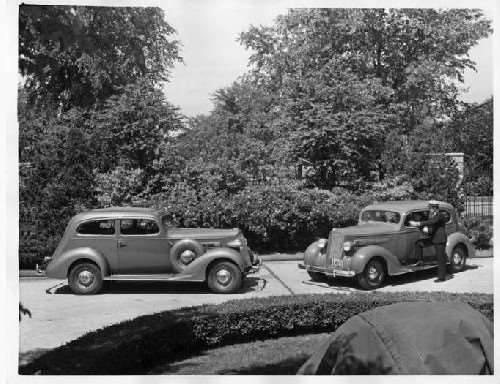
 (67.26 KB)
(67.26 KB)
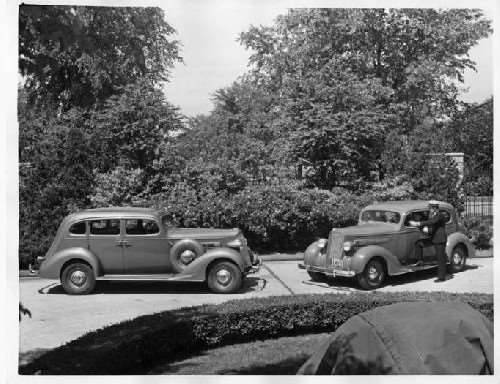
 (67.21 KB)
(67.21 KB)
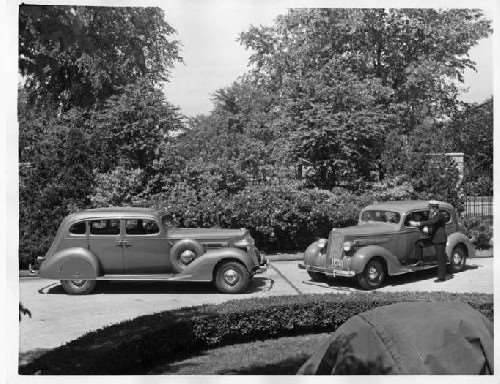
 (68.45 KB)
(68.45 KB)
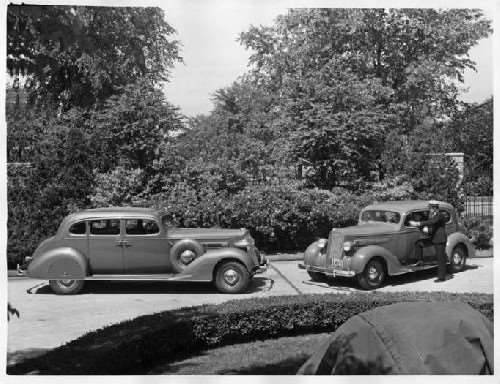
 (49.84 KB)
(49.84 KB)
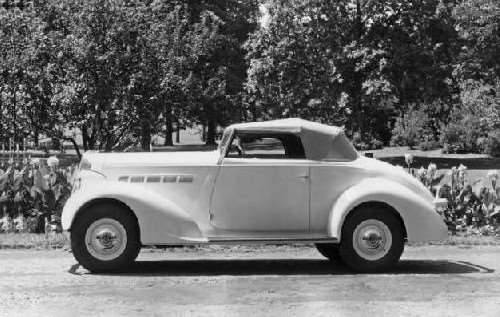
 (48.70 KB)
(48.70 KB)
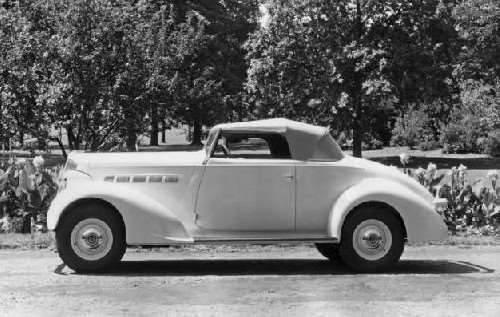
 (48.47 KB)
(48.47 KB)
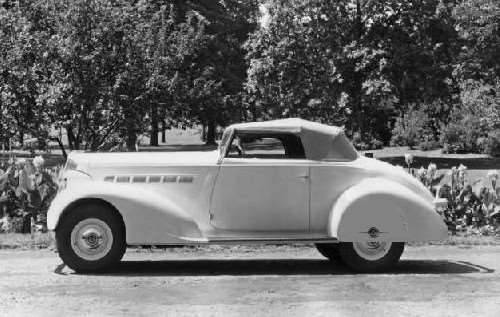
 (53.98 KB)
(53.98 KB)
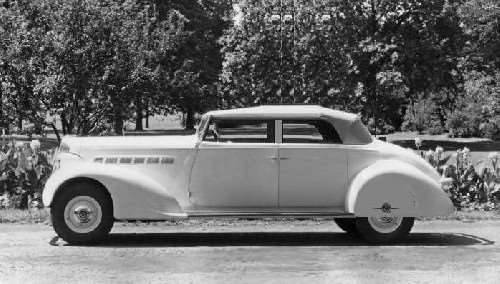
With this in mind, let's take a hard look at those '35 Seniors. Yes, they looked good, had presence, exuded luxury and offered high craftsmanship. But they were based on now old-school production methods, were heavy for their size, didn't have an independent front suspension like GM and didn't make good profits. My conclusion: they should have never been made!
Look back at 1923-24 when Packard dropped the Twin Six and abruptly shifted to its new flagship, the Eight, that was based on its more modern and production-efficient Six. For several years afterward, Packard's fortunes rose dramatically.
Now think about this analogy: in 1924, what if Packard had not made the new Eight but instead restyled the Twin Six and sold it alongside the Six for the next five years? Where would Packard have been in 1928? Quite possibly in the same boat Pierce-Arrow found itself in, having sold the old-school Model 33 alongside its new for 1925 Model 80.
With this in mind, I set to work once again on altering images of the One Twenty to see what was possible in terms of Senior potential, and came up with this:
- around 1933, Macauley would have realized that not only was a lower priced car of a completely new type needed, but that the current models had run their course, the competition having caught up to them in content and beaten them in value.
- Macauley would conclude that 1935 would need to be the year Packard once again made an about-face as it had in 1924. The entry and prestige cars would be based on the new One Twenty architecture, sharing many components and bodies. The money earmarked for restying the '34 Seniors would be redirected to the new program. Only if timing and resources prevented the new Seniors from launching in 1935 would the '34 models be carried over one more year. By 1936 at latest, all Packards would roll down the One Twenty line.
- let's give the new prestige cars a name... One Sixty, for lack on anything more creative... to represent their horsepower running on a new 356 I8 that was based on the One Twenty I8. Or perhaps they could have been called One Eighty, with a V12 based on the One Twenty I8 underhood. I have concluded that the motor powering these new Seniors was not as important as their bodies, styling, interior craftsmanship and One Twenty underpinnings.
- Junior bodies would become Seniors by simple addition of 6 inches to hood/front fender length.
- styling finesse would be the order of the day and Packard would get very persnickety about this. The standard One Twenty sedan had clean flowing lines in the rear. With a 6 inch longer hood mated to this body the new Seniors would look every bit as good as the Series 1200 sedan that we are familiar with. But the One Twenty touring sedan, club sedan and coupe sedan would not make it, their bustle back trunks not meeting the "only flowing lines" mantra. Instead, a coupe-sedan body on 6 inch shorter wheelbase would provide room of club sedan, and a new touring sedan on 10 inch wheelbase stretch from standard sedan would allow a decklid that flowed naturally from the body and didn't stick out 6 inches relative to the rear fenders, as the One Twenty's did.
- the CD-138 doors, which appear to have been 4 inches longer than the One Twenty's and with the rear door termination moved forward 10 inches, would form the basis for the 7 pass vehicles, on 138 wb for the One Twenty and 144 wb for One Sixty owing to longer hood.
- the former One Twenty 2-4 Coupe body would move back 6 inches to improve proportions, and would become a 2 pass only vehicle (question for forum: did rumble seats still sell in meaningful numbers by 1935?). The decklid and rear quarters would be used to make a Rollston or Dietrich-made convertible sedan and sport sedan on 144 wb with high price and low sales, an image car foretelling a body style that was almost ready for prime time. The sport sedan would use the convertible sedan's windshield, the coachbuilder hand-crafting a one-pierce roof of sleek design similar to '37 Rollston 1508 sport sedan.
Below are images of some of these models. The actual One Twenty is included as reference. All thoughts welcome!
Attach file:
 (67.37 KB)
(67.37 KB)
 (67.26 KB)
(67.26 KB)
 (67.21 KB)
(67.21 KB)
 (68.45 KB)
(68.45 KB)
 (49.84 KB)
(49.84 KB)
 (48.70 KB)
(48.70 KB)
 (48.47 KB)
(48.47 KB)
 (53.98 KB)
(53.98 KB)
This Post was from: https://packardinfo.com/xoops/html/modules/newbb/viewtopic.php?post_id=166053